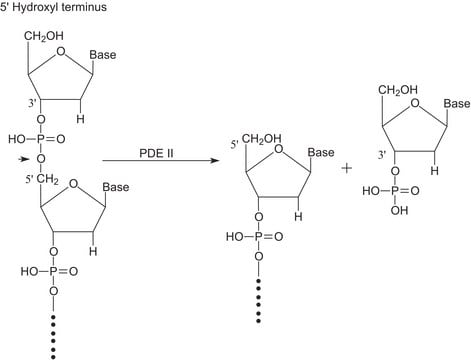추천 제품
생물학적 소스
Penicillium citrinum
Quality Level
양식
lyophilized powder
특이 활성도
≥200 units/mg protein (E1%/280, 3′-5′-Phosphodiesterase)
secondary activity
≥1,000 units/mg protein 3′-nucleotidase
분자량
42-50 kDa
포장
vial of ≥250 units (using RNA substrate)
기술
DNA extraction: suitable
DNA purification: suitable
적합성
suitable for molecular biology
응용 분야
cell analysis
유사한 제품을 찾으십니까? 방문 제품 비교 안내
일반 설명
Nuclease P1 from Penicillium citrinum is a zinc-dependent endonuclease that exhibits increased activity in the presence of low concentrations of urea. [1] Nuclease P1 selective activity has found useful applications in studies on nucleic acid structure.
애플리케이션
- Nuclease P1 cleave of single stranded DNA or RNA to 5′ mononucleotides
- Nuclease P1 supports DNA damage and modification research
- Nucleic acids base composition and structural analysis can be done by Nuclease P1
- Nuclease P1 has historically been used for the industrial production of 5′-mononucleotides from yeast RNA.
- Removal of nucleic acids through protein purification can be done by Nuclease P1
- Nuclease P1 is a key reagent for the development of methods for studies involving t-RNA dependent amino acid biosynthesis and t-RNA dependent trans-amidation
- Nuclease P1 from Penicillium citrinum has been used in a study to assess crystal structures using ammonium sulphate or polyethylene glycol 4000 as a precipitating agent.
- Nuclease P1 was used in a study to investigate a method for the direct sequence analysis 20-25 nucleotides from the terinini of 5′ or 3′ end group labeled RNA.
- Nuclease P1 is used to improve the sensitivity of a 32P-labeling method for the detection of DNA adducts.
생화학적/생리학적 작용
특징 및 장점
물리적 특성
단위 정의
3′-Nucleotidase: One unit will hydrolyze 1.0 μmole of orthophosphate from 3′-AMP per min at pH 7.2 at 37 °C.
신호어
Danger
유해 및 위험 성명서
예방조치 성명서
Hazard Classifications
Resp. Sens. 1
Storage Class Code
11 - Combustible Solids
WGK
WGK 3
Flash Point (°F)
Not applicable
Flash Point (°C)
Not applicable
개인 보호 장비
Eyeshields, Gloves, type N95 (US)
가장 최신 버전 중 하나를 선택하세요:
시험 성적서(COA)
이미 열람한 고객
자사의 과학자팀은 생명 과학, 재료 과학, 화학 합성, 크로마토그래피, 분석 및 기타 많은 영역을 포함한 모든 과학 분야에 경험이 있습니다..
고객지원팀으로 연락바랍니다.









